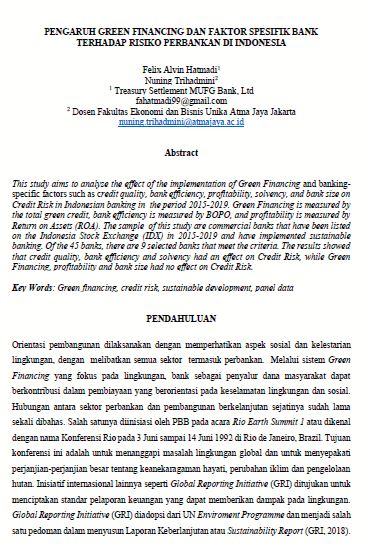PENGARUH GREEN FINANCING DAN FAKTOR SPESIFIK BANK TERHADAP RISIKO PERBANKAN DI INDONESIA
DOI:
https://doi.org/10.25170/jrema.v1i3.4579Keywords:
Green financing, credit risk, sustainable development, panel dataAbstract
This study aims to analyze the effect of the implementation of Green Financing and banking-specific factors such as credit quality, bank efficiency, profitability, solvency, and bank size on Credit Risk in Indonesian banking in the period 2015-2019. Green Financing is measured by the total green credit, bank efficiency is measured by BOPO, and profitability is measured by Return on Assets (ROA). The sample of this study are commercial banks that have been listed on the Indonesia Stock Exchange (IDX) in 2015-2019 and have implemented sustainable banking. Of the 45 banks, there are 9 selected banks that meet the criteria. The results showed that credit quality, bank efficiency and solvency had an effect on Credit Risk, while Green Financing, profitability and bank size had no effect on Credit Risk.
References
Aizawa, M., & Yang, C. (2011). Green Credit, Green Stimulus, Green Revolution? China’s Mobilization of Banks for Environmental Cleanup. The Journal of Environment & Development.
Aba, F. X. L. (2021). Institutional Change and Macroeconomic Variables in the ASEAN—Indonesia, Vietnam, and Cambodia: The Effects of a Trade War between China and USA. Economies, 9(4), 195.
Berger, A., & DeYoung, R. (1997). Problem loans and cost efficiency in commercial banks. J Bank.
Cui, Y., Geobey, S., Weber, O., & Lin, H. (2018). The Impact of Green Lending on Credit Risk in China. MDPI, 2-17.
Handajani, L., Husnan, L. H., & Rifai, A. (2019). Kajian Tentang Inisiasi Praktik Green Banking Pada Bank BUMN Di Indonesia. Jurnal Economia Review of Business and Economics, 1-16.
Hellmann, T. F., Murdock, K. C., & Stiglitz, J. E. (2000). Liberalization, Moral Hazard in Banking and Prudential Regulation: Are Capital Requirements Enough? SSRN, 157-165.
Hoehne, Khosla, Fekete, & Gilbert. (2011). Mapping of Green Finance Deliyered by IDFC Members. Ecofys.
Kasmir. (2013). Analisis Laporan Keuangan. Jakarta: Raja Grafindo Persada.
Kosmidou, K., & Zopounidis, C. (2008). Measurement of Bank Performance in Greece. South-Eastern Europe Journal of Economics, 1-18.
Krugman, P. (1999). Balance sheets, the transfer problem, and financial crises. Kluwer Academic Publishers.
Makri, V., Tsagkanos, A., & Bellas, A. (2014). Determinants of non-performing loans: The case of Eurozone. Panoeconomicus, 193-206.
Mengze, H., & Wei, L. (2015). A Comparative Study on Environment Credit Risk Management of Commercial Banks in the Asia Pacific Region. Wiley Online Library, 1-16.
N. Höhne‚ N. Braun‚ H. Fekete‚ R. Brandsma‚ J. Larkin‚ M.G.J. den Elzen‚ M. Roelfsema‚ A.F. Hof‚ H. Böttcher. 2012. Greenhouse Gas Emission Reduction Proposals and National Climate Policies of Major Economies. PBL Netherlands Environmental Assessment Agency. Bilthoven
Prasanjaya, A., Yogi, A., & Ramanatha, I. (2013). Analisis Pengaruh Rasio CAR, BOPO, LDR, Dan Ukuran Peruahaan Terhadap Profitabilitas Bank Yang Terdaftar Di BEI. E-jurnal Akuntansi Universitas Udayana, 230-245.
Prawoto, A. T. (2016). Analisis Regresi Dalam Penelitian Ekonomi Dan Bisnis. Depok: Kharisma Putra Utama Offset.
Pricewaterhouse Coopers. (2013). Exploring Green Finance Incentives in China.
Stern, G. H., & Feldman, R. J. (Brookings). Too Big to Fail. 2004.
Rosengard, J. K., & Prasetyantoko, A. (2011). If the banks are doing so well, why can't I get a loan? Regulatory constraints to financial inclusion in Indonesia. Asian Economic Policy Review, 6(2), 273-296.
Saadah, S., & Prijadi, R. (2012). Capital structure's dynamic response to exogenous variables: A case of listed manufacturing firms in Indonesia. International Journal of Financial Research, 3(2), 86.
Saddah, S., & Sitanggang, M. L. (2020). Value at risk estimation of exchange rate in banking industry. Jurnal Keuangan dan Perbankan, 24(4), 474-484.
Trihadmini, N., & Falianty, T. A. (2020). Stock market contagion and spillover effects of the global financial crisis on five ASEAN countries. Institutions and Economies, 91-119.
Weber, O., Scholz, R. W., & Michalik, G. (2008). Incorporating Sustainability Criteria into Credit Risk Management. Wiley InterScience, 2-13.
Zeidan, R., Boechat, C., & Fleury, A. (2015). Developing a sustainability credit score system. . J Bus, 283-296.
Zhang, B., Yang, Y., & Bi, J. (2011). Tracking the implementation of green credit policy in China: top-down perspective and bottom-up reform. Journal of environmental management.
Zhou, X., Caldecott, B., Hoepner, A., & Wang, Y. (2020). Bank Green Lending and Credit Risk. SWIFT.




